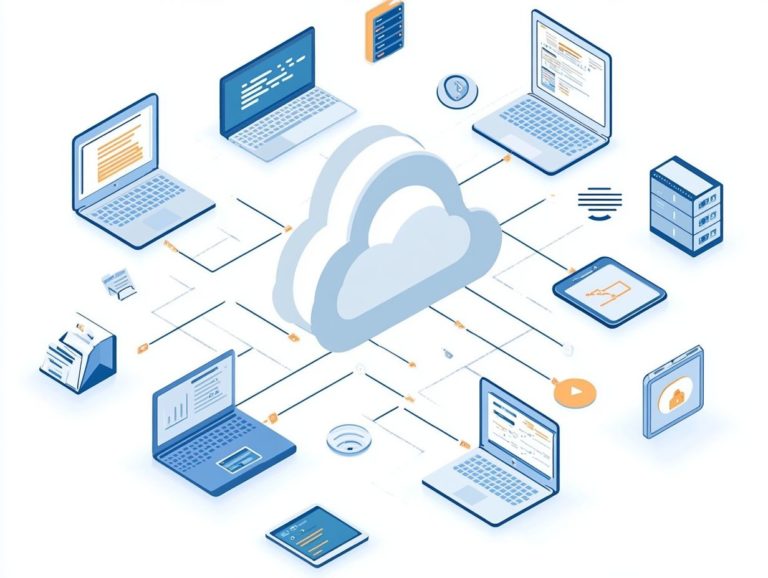5 Best Practices for SaaS Product Management
In the fast-paced realm of Software as a Service (SaaS), effective product management is essential for your success.
This article delves into five best practices that can empower you as a SaaS product manager. From gaining a deep understanding of your target audience to implementing agile methodologies, each practice is crafted to enhance user experience and drive your business growth.
You ll explore key responsibilities, master communication strategies, tackle common challenges, and identify the essential skills every SaaS product manager should possess.
Get ready to take your product management skills to the next level!
Contents
- Key Takeaways:
- 1. Understand Your Target Audience
- 2. Continuously Gather and Analyze User Feedback
- 3. Prioritize Features Based on User Needs and Business Goals
- 4. Implement Agile Development Methodology
- 5. Regularly Monitor and Measure Product Performance
- What Is SaaS Product Management and Why Is It Important?
- What Are the Key Responsibilities of a SaaS Product Manager?
- How Can a SaaS Product Manager Effectively Communicate with Stakeholders?
- What Are the Common Challenges Faced by SaaS Product Managers?
- How Can a SaaS Product Manager Stay Up-to-Date with Industry Trends?
- What Are the Essential Skills for a Successful SaaS Product Manager?
- Frequently Asked Questions
- What are the top 5 best practices for SaaS product management?
- How important is it to define clear product goals in Software as a Service (SaaS) product management?
- Why prioritize features based on customer needs in SaaS product management?
- How does continuous market research benefit SaaS product management?
- What is the importance of collaborating with cross-functional teams?
- How does collecting and analyzing user feedback contribute to effective SaaS product management?
Key Takeaways:

- Understand your target audience to tailor your product to their needs and preferences.
- Continuously gather and analyze user feedback to make informed decisions and improve the product.
- Prioritize features based on both user needs and business goals to ensure a successful and profitable product.
1. Understand Your Target Audience
Understanding your target audience is crucial in managing software products. This knowledge enables you to align your product features and enhancements with what users actually need, boosting customer satisfaction and product adoption.
By employing effective market research strategies and analyzing customer behavior, you’ll uncover valuable insights that can shape your product roadmap and user experience design. This knowledge helps you find what frustrates customers and create a user-centric design that resonates with your audience.
One effective way to identify your target audience is through user research. Direct interactions with potential users can reveal their preferences, habits, and challenges.
Surveys are another great tool to gather broader quantitative data, allowing you to refine your audience segmentation and tailor your messaging to speak directly to their desires.
Keeping an eye on market trends gives you the power to proactively adapt your product in response to evolving user expectations. By grasping user behavior, you’ll position your team to iterate on features that truly matter, fostering a reliable feedback loop that enhances the product and strengthens customer relationships over time.
2. Continuously Gather and Analyze User Feedback
Continuously gathering and analyzing user feedback is crucial for enhancing the user experience and ensuring that your SaaS product evolves alongside your customers’ needs. To accomplish this, you can employ various methods:
- Usability testing allows you to observe users as they interact with your product.
- Surveys can quickly collect quantitative data from a broad audience.
- Customer interviews provide rich qualitative insights that delve deeper into user experiences.
Each of these methods serves a vital purpose in identifying pain points and understanding user preferences. Once you ve collected feedback, the real magic happens in the analysis phase transforming raw data into actionable insights that drive product improvements, boost customer satisfaction, and inform future iterations of your offering.
This iterative approach not only helps refine features but also strengthens the bond between your product and its users.
3. Prioritize Features Based on User Needs and Business Goals
Prioritizing features based on user needs and business goals is essential for effective SaaS product management. It ensures that your product roadmap meets customer demands and aligns seamlessly with your overarching business objectives.
This alignment enhances customer satisfaction and supports sustainable growth. To build a robust prioritization framework, product managers can employ techniques like the MoSCoW method, which sorts features into Must-haves, Should-haves, Could-haves, and Won’t-haves.
By pinpointing essential features that users deem necessary, your team can concentrate on delivering incremental value that resonates with your audience. Striking this balance enhances customer engagement and makes users feel appreciated for their input, driving product adoption and cultivating loyalty.
This thoughtful strategy turns user feedback into actionable insights, ensuring they align perfectly with your strategic business goals.
In conclusion, start applying these tips today to see immediate improvements in your product management!
4. Implement Agile Development Methodology

Implementing an agile development methodology gives your tech team the power to respond swiftly to evolving market demands and customer feedback. This cultivates a culture of continuous improvement and innovation in SaaS product management.
This approach not only maintains flexibility but also emphasizes collaboration across various functional teams an essential element for enhancing product testing and quality assurance processes.
By breaking down silos, your developers can work closely with designers, marketers, and product owners. This fosters a unified vision that elevates overall product quality.
The iterative development cycles intrinsic to agile allow your teams to refine features gradually based on genuine user feedback. This results in products that not only meet but often surpass customer expectations, setting the stage for improved long-term engagement and satisfaction.
5. Regularly Monitor and Measure Product Performance
Regularly monitoring and measuring product performance is essential for ensuring your SaaS offerings remain relevant and valuable to your users. This practice gives you the power to adapt to changing market demands and customer preferences.
By using key metrics, you can gain valuable insights into how your product is performing in real-world scenarios. For instance, metrics like user engagement rates show how actively users are interacting with your features, while customer satisfaction scores illuminate users’ happiness and loyalty.
Analyzing this data not only highlights your successes but also uncovers potential issues that could impede future growth. As a result, you can refine your product offerings, implement necessary changes, and align your strategies to better meet user needs. This fosters continuous innovation and ultimately drives your success.
What Is SaaS Product Management and Why Is It Important?
SaaS product management involves overseeing the development, launch, and lifecycle of software products delivered as a service. It plays a crucial role in ensuring customer satisfaction while aligning your offerings with market trends and demands.
This approach also creates a seamless user experience and encourages continuous improvement and innovation. By actively monitoring user feedback and market dynamics, you can adapt features and capabilities to meet ever-evolving expectations.
In today s fast-paced environment, grasping the product lifecycle is paramount. It enables you to strategically navigate through essential phases such as initiation, development, and growth.
Staying relevant in rapidly changing markets is critical. Therefore, leveraging agile methodologies and data analytics gives you the power to make informed decisions that enhance your competitive advantage and propel your software evolution forward.
What Are the Key Responsibilities of a SaaS Product Manager?
The key responsibilities of a SaaS product manager encompass a vast array of tasks, from defining the product roadmap to enhancing user experience and facilitating cross-functional collaboration. This ensures that various teams align with customer feedback and market requirements.
- Analyze market trends to keep your product competitive.
- Gather insights directly from users to refine functionalities.
- Establish a clear vision that influences the prioritization of features and enhancements.
- Communicate effectively with stakeholders to articulate the value proposition.
- Balance technical constraints with user needs to impact the product s success.
Ultimately, your ability to balance these aspects will significantly impact the product s success in the marketplace, making your role essential in the ever-evolving SaaS landscape.
How Can a SaaS Product Manager Effectively Communicate with Stakeholders?

Effective communication with stakeholders is crucial for you as a SaaS product manager. The product vision must resonate clearly, requirements should be unambiguous, and collaboration among teams needs to be optimized for success.
Establishing a routine of regular updates and stakeholder meetings enhances transparency and builds trust. Use collaborative tools like Slack or Microsoft Teams to facilitate real-time discussions and quick decision-making, breaking down barriers that often emerge in remote environments.
Implementing feedback systems encourages active participation, allowing stakeholders to share their insights and concerns. This ongoing dialogue bolsters engagement and fosters a shared understanding of project goals, ensuring everyone stays aligned throughout the development process.
What Are the Common Challenges Faced by SaaS Product Managers?
As a SaaS product manager, you will face a range of challenges. Navigating customer pain points, balancing product features with market demand, and keeping pace with the rapid evolution of software can be quite challenging.
Resource limitations may stifle both innovation and responsiveness to market trends. Prioritizing which features to develop becomes a strategic balancing act, as it’s vital to address user needs while staying within budget constraints.
Managing stakeholder expectations can feel like walking a tightrope, with differing priorities and visions for product direction often clashing. To tackle these hurdles, adopt a clear roadmap, utilize a flexible approach to project management for quicker iterations, and foster open communication channels.
These strategies can significantly enhance your success in product management.
How Can a SaaS Product Manager Stay Up-to-Date with Industry Trends?
Stay ahead of the curve by diving into market research, conducting thorough competitor analysis, and actively engaging in relevant networks and forums. This ensures your product evolves in harmony with shifting customer expectations.
Attending industry conferences proves invaluable for gaining insights; these events often showcase leading experts who share cutting-edge advancements and compelling case studies. Follow thought leaders to stay informed and tap into a continuous stream of ideas that enhance your product strategy.
Leveraging these resources deepens your understanding of the market landscape and informs your product development process, ensuring your offerings resonate with customer needs. This strategic approach boosts customer engagement, cultivates loyalty, and propels growth in an increasingly competitive environment.
What Are the Essential Skills for a Successful SaaS Product Manager?
As a successful SaaS product manager, cultivate a robust understanding of product management principles, master agile methodologies, and develop the ability to conduct thorough user research that informs your product decisions.
Beyond these foundational skills, critical analytical thinking is essential for dissecting complex data and market trends. This enables you to make informed choices that align with your business goals.
Strong communication skills are equally important, facilitating collaboration across multidisciplinary teams and ensuring all stakeholders remain aligned on the product vision and strategy.
Effective leadership is crucial for guiding your teams through challenges while fostering a culture of innovation. Together, these abilities empower you to navigate dynamic environments, anticipate customer needs, and drive successful product outcomes.
Frequently Asked Questions

What are the top 5 best practices for SaaS product management?
- Define clear product goals.
- Prioritize features based on customer needs.
- Conduct continuous market research.
- Collaborate with cross-functional teams.
- Regularly collect and analyze user feedback.
How important is it to define clear product goals in Software as a Service (SaaS) product management?
Defining clear product goals is crucial in SaaS management. It gives the team direction and helps prioritize features aligned with the overall strategy.
Why prioritize features based on customer needs in SaaS product management?
When features are based on customer needs, the team focuses on what truly adds value. This approach boosts customer satisfaction and retention.
How does continuous market research benefit SaaS product management?
Continuous market research keeps product managers informed about industry trends. This knowledge helps them make decisions that adapt to customer needs.
What is the importance of collaborating with cross-functional teams?
Collaboration with teams like engineering, marketing, and sales provides valuable insights. This collaboration leads to a more effective product strategy.
How does collecting and analyzing user feedback contribute to effective SaaS product management?
Regular feedback collection helps managers understand how customers use the product. It identifies areas for improvement that match customer preferences.






